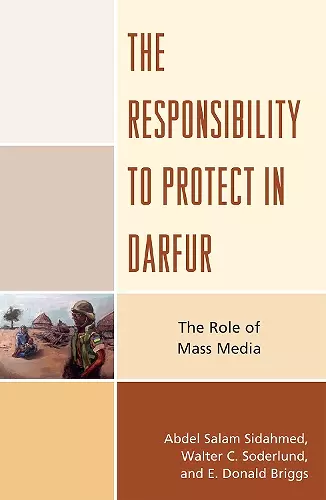The Responsibility to Protect in Darfur
The Role of Mass Media
Walter C Soderlund author Abdel Salam Sidahmed author Donald E Briggs author
Format:Hardback
Publisher:Lexington Books
Published:15th Feb '10
Currently unavailable, and unfortunately no date known when it will be back
This hardback is available in another edition too:
- Paperback£45.00(9780739138076)

Long-simmering conflict in the Sudanese region of Darfur came to a boil in the spring of 2003 and became a focus of American media attention in September 2004. After the genocide in Rwanda the international community developed a new way to deal with genocide-the "Responsibility to Protect" doctrine which legitimized intervention in case of egregious loss of human life. Despite this new doctrine, it took over five years of conflict in Darfur before the U. N. began intervening. The Responsibility to Protect in Darfur: The Role of Mass Media, traces the development of international intervention in domestic conflict, culminating in the concept of "Responsibility to Protect" in 2001. The authors explain the background and complexity of the crisis besetting Darfur, and document U.S. media coverage of the crisis in terms of framing that would mobilize public opinion behind international intervention. The book traces evolution in international norms regarding state sovereignty and human rights that led to the articulation of "Responsibility to Protect" and its subsequent adoption by the international community in 2005. It provides an understanding of the complex nature of the Darfur crises, in a way that was seriously lacking in media coverage. The authors also analyze the affects media coverage of the crisis had on the world's reaction, particularly in the U.S. Specifically it looks at television coverage of the crisis, and the newspaper coverage, particularly through The New York Times. Finally, the authors ask if "Responsibility to Protect" was helpful in Darfur, and if it will be in the future for other countries.
Sidahmed, Soderlund, and Briggs (all, Univ. of Windsor, Canada) present two essays in just over 100 pages. One is a rapid survey of the proclaimed genocide in Darfur, centering on the contradiction of respect for state sovereignty and the doctrine of an international responsibility to protect (R2P) citizens inside states. The second is a survey of the several years of reporting and interpretation by the mass media. The audience for the first will find a workmanlike summary of events. The audience for the second will find a useful short investigation of how the media treated news of the mass killings and the issue of intervention. The New York Times as the exemplar of serious press gains special attention; Nicholas Kristof is credited with keeping the Darfur story alive. The media section of this book reflects some original research with interesting analyses of the nature and amount of coverage. Overall, the conclusions are unsurprising: R2P remains a failure in Darfur, and how to square the doctrine of state sovereignty with the actual ability to enforce remains a dilemma. As readers might expect, the mass media does an inadequate job of covering continuing humanitarian crises. Copious appendixes and bibliography. Recommended. * CHOICE, September 2010 *
Media coverage of the Sudan government's onslaught on Darfur villages alerted the world and—for a while—reduced the frequency of the attacks. The acknowledgement in the UN of the international "Responsibility to Protect" raised the Darfuris' hopes that the world would help them. But what stopped brave reporting and well intentioned institutional words from prompting effective action? This downbeat examination of the war in Darfur takes a close and sobering look at the arguments over international protective intervention and the fraught role of media coverage. It shines a useful light on often overlooked aspects of the conflict and the way that actions have fallen far behind the words. -- Peter Verney, editor of Sudan Update, and author of Raising the Stakes: Oil and Conflict in Sudan
Relevance and accessibility to various audiences are important strengths of The Responsibility to Protect. The book leaves out much of the jargon that makes academic books inaccessible to audiences outside of academia, and often inaccessible outside of specific disciplines and subdisciplines….This book includes significant empirical research on how the media cover world events, and how this coverage might influence the public and policymakers. It offers important background information on the human rights abuses and humanitarian crisis in Darfur. Their findings that the media influences how the public thinks about current events are even more relevant today as the world watches media coverage of new and continuing human rights abuses in Egypt, Tunisia, and Iran, and humanitarian crises in Haiti, south Sudan, and, of course, Darfur. * H-Net: Humanities and Social Science Reviews Online *
ISBN: 9780739138069
Dimensions: 241mm x 162mm x 17mm
Weight: 433g
172 pages